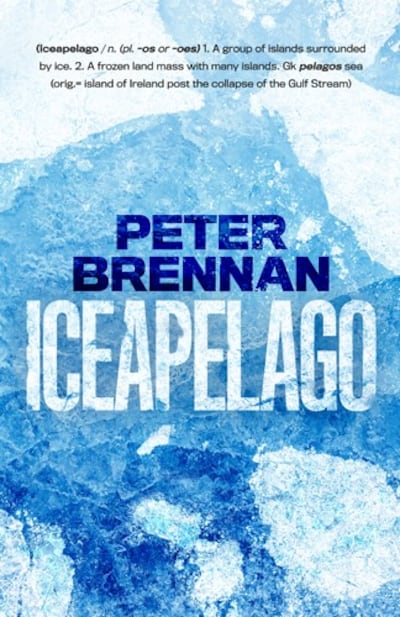Iceapelago is a new word for a new world. Iceapelago is a plot-driven climate change thriller: a new cli-fi (climate fiction) genre.
Iceapelago describes a country – in this case the island of Ireland – with ice-covered seas and lands, multiple small islands and where winter has come to stay forever. Iceapelago is formed after tsunamis destroyed the landscape. Rising sea levels caused by the melting of the Greenland Ice Sheet and winter ice conditions resulting from the collapse of the Gulf Stream force the humans who survive to adapt. The first migrants are Artic foxes.
The three separate but interconnected story lines with chain reactions take place at some time in the near future.
This is fiction which, hopefully, will never become fact.

I visited the first location, La Palma, the least known of the Canary Islands, with my wife in January 2019. It is a hillwalker’s paradise. We walked all the trails and witnessed dramatic skylines, volcanic dykes, lava paths, and changing weather patterns.
In the book, Spanish research students doing summer vacation work discover the first signs of volcanic activity in an area hitherto dormant. This triggers an international response. The 8km ridge of the Caldera de Taburiente that dominates the centre of the island explodes with dire consequences, not just for the local population.
The second storyline takes place in Greenland, where scientists working in the Summit Station – 3,000 metres atop the ice sheet – undertake tests to determine the flow of surface meltwater as it cascades through the glacier’s crevasses and sub-surface lakes to sea level. An innovative tracking device is used. They find evidence of the rapid pace of melting of the Greenland Ice Sheet: a tipping point and a direct threat to the nations of the North Atlantic.
My research trip in July 2019 involved taking eight flights, including two by helicopter. If La Palma’s scenery was stunning, Greenland’s vast and changing landscape defies description. I flew over the top of the Ice Sheet and photographed seas of melting ice. I took several escorted tours around the glacier graveyard close to Ilulissat on the west coast and inside the Arctic Circle. I also travelled to Tasiilaq on the east coast: a small isolated Inuit community also surrounded by melting glaciers. It was unseasonably warm at 18 degrees.
I could not travel to the Eriador Seamount at the edge of Ireland’s Continental Shelf, the scene of the third story, but thanks to the Marine Institute I spent several hours on their research vessel talking about the ship’s routines, procedures and its marine research activity. Based in Galway Harbour, the RV Celtic Explorer is a state-of-the-art resource. I hope the huge commitment of its crew comes across in the chapters of Iceapelago that cover the disruption of the Gulf Stream and the impact of its collapse.
I spent four months writing up and integrating the three story lines and developing the characters and their narrative. At 85,000 words I thought I had done the business. Having attended Dalkey Creative in November 2019; having listened to the sage advice of Vanessa Fox O’Loughlin of the Inkwell Group; and, after attending a six-week creative writing workshop facilitated by the masterful Ferdia MacAnna, I discovered my academic style of writing with attention to (too much) detail did not deliver a compelling and free-flowing novel.
Iceapelago was a great story, but… I rewrote every chapter; recast and polished the dialogue; and dropped lots of background information that got in the way of readers’ understanding of the characters and the plot itself.
Writing fiction has also opened my eyes to the complex and competitive world of publishing. To my mind, self-publishing is the only viable route to market for a new author. Publishers will not take a risk with a newbie. As a general rule, literary agents also shun new authors. I used my budget in getting a professionally design cover for the book; launching an Iceapelago website; signing up with social media; appointing advisers to format the book to meet KDP and Ingramspark’s technical requirements; and used a specialist PR company to drive initial sales.
Niamh Hatton did a brilliant job copy-editing and proofing the final manuscript. I cannot thank her enough for turning my literary efforts into what I hope is a good read. Rebecca and Andrew at Ardel Media were creative, helpful, professional and good value for a new author. I am indebted to them for converting my work into a polished finished product.
This is my first work of fiction. It was inspired by my long interest over 20 years in climate change policy and climate science. While doing my day job, I am writing the sequel: Iceapelago: The Aftermath.
I have two ambitions for Iceapelago. That readers will better appreciate the value of nature and the threats to the global environment. Secondly, that someone will see its potential as a film. No harm in being ambitious!




















